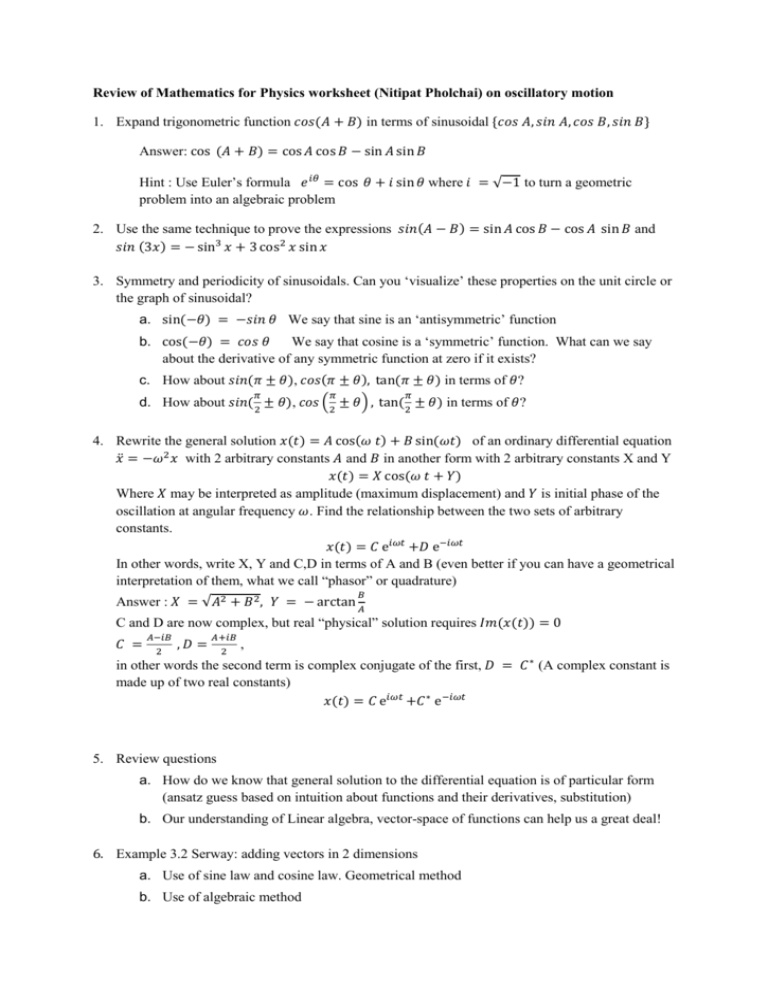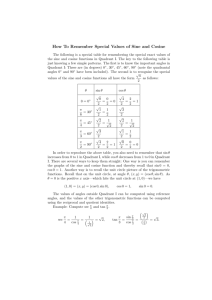Review of Mathematics for Physics worksheet (Nitipat Pholchai) on
advertisement

Review of Mathematics for Physics worksheet (Nitipat Pholchai) on oscillatory motion
1. Expand trigonometric function 𝑐𝑜𝑠(𝐴 + 𝐵) in terms of sinusoidal {𝑐𝑜𝑠 𝐴, 𝑠𝑖𝑛 𝐴, 𝑐𝑜𝑠 𝐵, 𝑠𝑖𝑛 𝐵}
Answer: cos (𝐴 + 𝐵) = cos 𝐴 cos 𝐵 − sin 𝐴 sin 𝐵
Hint : Use Euler’s formula 𝑒 𝑖𝜃 = cos 𝜃 + 𝑖 sin 𝜃 where 𝑖 = √−1 to turn a geometric
problem into an algebraic problem
2. Use the same technique to prove the expressions 𝑠𝑖𝑛(𝐴 − 𝐵) = sin 𝐴 cos 𝐵 − cos 𝐴 sin 𝐵 and
𝑠𝑖𝑛 (3𝑥) = − sin3 𝑥 + 3 cos2 𝑥 sin 𝑥
3. Symmetry and periodicity of sinusoidals. Can you ‘visualize’ these properties on the unit circle or
the graph of sinusoidal?
a. sin(−𝜃) = −𝑠𝑖𝑛 𝜃 We say that sine is an ‘antisymmetric’ function
b. cos(−𝜃) = 𝑐𝑜𝑠 𝜃
We say that cosine is a ‘symmetric’ function. What can we say
about the derivative of any symmetric function at zero if it exists?
c. How about 𝑠𝑖𝑛(𝜋 ± 𝜃), 𝑐𝑜𝑠(𝜋 ± 𝜃), tan(𝜋 ± 𝜃) in terms of 𝜃?
𝜋
𝜋
𝜋
d. How about 𝑠𝑖𝑛( 2 ± 𝜃), 𝑐𝑜𝑠 ( 2 ± 𝜃) , tan( 2 ± 𝜃) in terms of 𝜃?
4. Rewrite the general solution 𝑥(𝑡) = 𝐴 cos(𝜔 𝑡) + 𝐵 sin(𝜔𝑡) of an ordinary differential equation
𝑥̈ = −𝜔2 𝑥 with 2 arbitrary constants 𝐴 and 𝐵 in another form with 2 arbitrary constants X and Y
𝑥(𝑡) = 𝑋 cos(𝜔 𝑡 + 𝑌)
Where 𝑋 may be interpreted as amplitude (maximum displacement) and 𝑌 is initial phase of the
oscillation at angular frequency 𝜔. Find the relationship between the two sets of arbitrary
constants.
𝑥(𝑡) = 𝐶 e𝑖𝜔𝑡 +𝐷 e−𝑖𝜔𝑡
In other words, write X, Y and C,D in terms of A and B (even better if you can have a geometrical
interpretation of them, what we call “phasor” or quadrature)
𝐵
Answer : 𝑋 = √𝐴2 + 𝐵2 , 𝑌 = − arctan 𝐴
C and D are now complex, but real “physical” solution requires 𝐼𝑚(𝑥(𝑡)) = 0
𝐶 =
𝐴−𝑖𝐵
2
,𝐷 =
𝐴+𝑖𝐵
2
,
in other words the second term is complex conjugate of the first, 𝐷 = 𝐶 ∗ (A complex constant is
made up of two real constants)
𝑥(𝑡) = 𝐶 e𝑖𝜔𝑡 +𝐶 ∗ e−𝑖𝜔𝑡
5. Review questions
a. How do we know that general solution to the differential equation is of particular form
(ansatz guess based on intuition about functions and their derivatives, substitution)
b. Our understanding of Linear algebra, vector-space of functions can help us a great deal!
6. Example 3.2 Serway: adding vectors in 2 dimensions
a. Use of sine law and cosine law. Geometrical method
b. Use of algebraic method
Type equation here.











